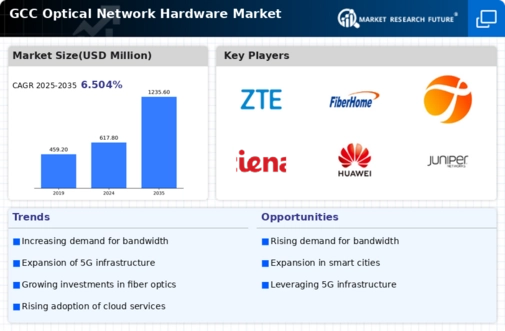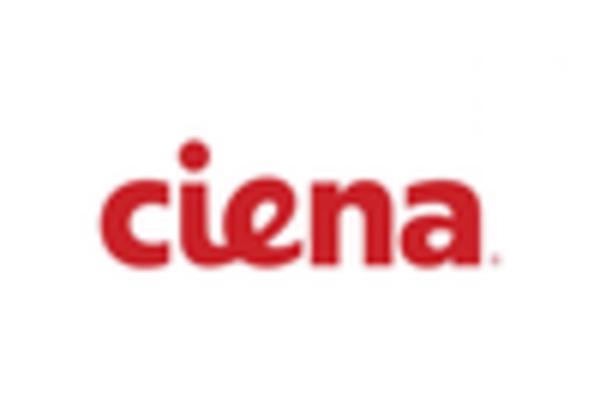The optical network-hardware market is currently characterized by intense competition and rapid technological advancements. Key growth drivers include the increasing demand for high-speed internet, the expansion of 5G networks, and the rising adoption of cloud services. Major players such as Cisco Systems (US), Huawei Technologies (CN), and Nokia (FI) are strategically positioned to leverage these trends. Cisco Systems (US) focuses on innovation and digital transformation, emphasizing software-defined networking and security solutions. In contrast, Huawei Technologies (CN) is heavily investing in R&D to enhance its optical transmission technologies, while Nokia (FI) is pursuing strategic partnerships to bolster its market presence and expand its service offerings. Collectively, these strategies shape a competitive environment that is both dynamic and multifaceted, with companies vying for leadership through technological differentiation and strategic collaborations.
Key business tactics in the optical network-hardware market include localizing manufacturing and optimizing supply chains to enhance operational efficiency. The market structure appears moderately fragmented, with several key players holding substantial market shares. This fragmentation allows for a diverse range of offerings, yet the collective influence of major companies like Cisco Systems (US) and Huawei Technologies (CN) tends to dominate market trends and pricing strategies. As these companies continue to innovate and expand their capabilities, they significantly impact the overall competitive landscape.
In October 2025, Cisco Systems (US) announced a strategic partnership with a leading telecommunications provider in the GCC region to enhance its 5G network capabilities. This collaboration aims to integrate advanced optical networking solutions, thereby improving network performance and reliability. The strategic importance of this partnership lies in Cisco's ability to leverage its technological expertise to meet the growing demand for high-speed connectivity, positioning itself as a leader in the evolving telecommunications landscape.
In September 2025, Huawei Technologies (CN) unveiled its latest optical transmission technology, which reportedly increases data transmission capacity by 50% compared to previous generations. This innovation is crucial as it addresses the escalating demand for bandwidth driven by cloud computing and streaming services. By enhancing its product offerings, Huawei strengthens its competitive edge and reinforces its commitment to R&D, which is vital for maintaining market relevance.
In August 2025, Nokia (FI) completed the acquisition of a regional optical networking firm, aiming to expand its portfolio and enhance its service capabilities in the GCC market. This acquisition is strategically significant as it allows Nokia to integrate new technologies and expertise, thereby improving its competitive positioning. The move reflects a broader trend of consolidation within the industry, as companies seek to enhance their technological capabilities and market reach.
As of November 2025, current competitive trends in the optical network-hardware market are increasingly defined by digitalization, sustainability, and the integration of AI technologies. Strategic alliances are becoming more prevalent, as companies recognize the need to collaborate to drive innovation and address complex market demands. Looking ahead, competitive differentiation is likely to evolve, shifting from price-based competition to a focus on innovation, technological advancements, and supply chain reliability. This transition underscores the importance of agility and responsiveness in a rapidly changing market environment.

















Leave a Comment